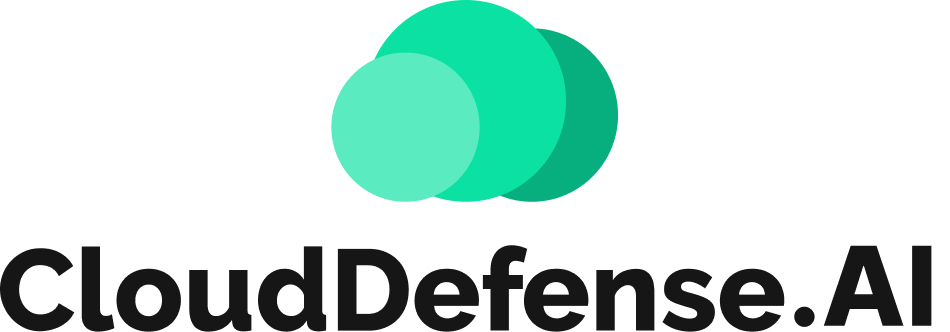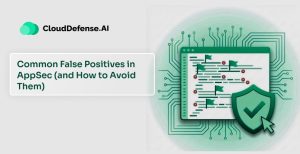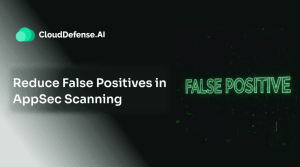What is NIST 800-218?
NIST 800-218, also known as the Secure Software Development Framework (SSDF), is essentially a blueprint for building software with security at its core. Developed by the National Institute of Standards and Technology (NIST), it’s designed to help developers incorporate security measures throughout the entire software development process.
But what does that actually mean for you as a developer? Instead of treating security as a box to check at the end, the SSDF encourages you to think about security from the very beginning. It’s about making security an integral part of every stage – whether you’re planning, coding, testing, or deploying.
One of the key ideas here is that security isn’t a one-time thing. It’s something you need to keep in mind constantly. This means adopting secure coding practices from the start and continuously testing for vulnerabilities along the way.
And automation? That’s a big part of the framework too. If you’re automating tasks like code scans and security checks, you can catch potential issues early, reducing the risk of a security breach later on. Ultimately, NIST 800-218 is about embedding security into your development culture.
By following these guidelines, you’re not just complying with standards, you’re building more robust software that’s better equipped to handle the increasingly common security challenges. It’s about being proactive rather than reactive when it comes to security.
Four Main Components of SSDF
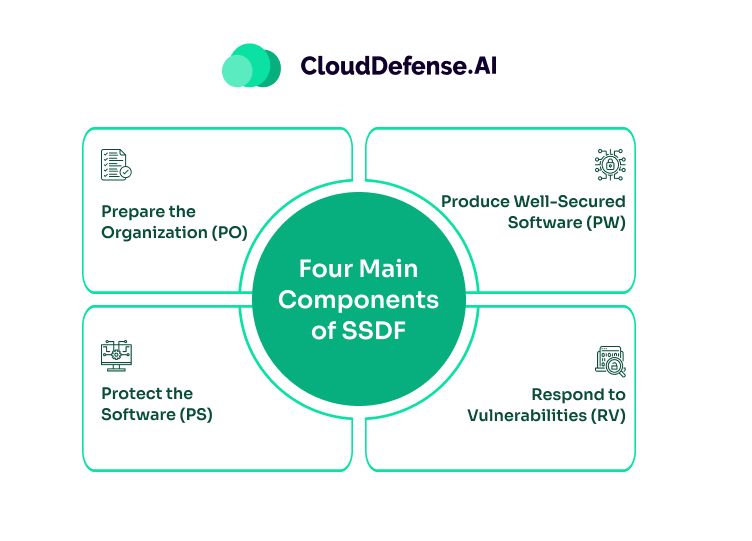
The NIST 800-218 framework lays out a set of guidelines to help you build secure software from the ground up. It breaks everything down into four main practices, each with its own set of steps to follow. Here’s a more straightforward look at what those practices involve.
1. Prepare the Organization (PO)
First things first, before you even start coding, you need to get your organization ready for secure software development. This means making sure everyone understands the importance of security, from the leadership team to the developers. It’s not just about telling people that security matters, though. You need to figure out the specific security needs of your software based on the tools and processes you’re using.
This might involve:
- Training your team: Make sure everyone knows what’s expected of them when it comes to security.
- Getting management on board: Ensure that leadership is supportive of security initiatives and understands their value.
- Setting up your tools: Implement technologies that can help automate security tasks and protect your software.
For example, if you introduce a new security tool, don’t just toss it into the mix, instead take the time to train your team on how to use it and explain why it’s important for keeping your software safe.
2. Protect the Software (PS)
Once your team is prepared, the next step is to protect your software from unauthorized access or tampering. This isn’t just about stopping hackers; it’s also about preventing accidental changes that could introduce vulnerabilities.
Here’s what you can do:
- Control access: Limit who can see and change your code.
- Use encryption: Protect sensitive parts of your software with encryption.
- Monitor changes: Keep track of any changes made to your code to ensure everything is above board.
For example, if you’re dealing with a codebase being developed in-house, make sure only authorized team members have access to it. All this reduces the potential for errors or even malicious changes that might expose your software.
3. Produce Well-Secured Software (PW)
Now comes the actual development part. As you build your software, you need to make sure you’re doing it securely every step of the way. This means thinking about security as you code, test, and review your work.
Here’s what to focus on:
- Choose secure settings: Make sure your software configurations are secure from the start.
- Check third-party components: If you’re using external libraries or tools, make sure they’re safe and up-to-date.
- Write secure code: Follow best practices for secure coding to avoid common vulnerabilities.
- Test thoroughly: Regularly test and review your code to catch any security issues early on.
- Use secure tools: Leverage tools like SAST and SCA that help prevent security problems during the build process.
For example, if you’re pulling in a third-party library, don’t just assume it’s safe. Verify that it’s from a reliable source and that it’s actively maintained so you’re not introducing unnecessary risks into your software.
4. Respond to Vulnerabilities (RV)
Even with all the best practices in place, security vulnerabilities can still slip through the cracks. That’s why it’s important to be ready to respond quickly if (and when) they’re discovered.
Here’s how to handle it:
- Set up a process: Have a clear system for reporting and addressing vulnerabilities.
- Get a team ready: Designate people or a team to respond to security issues as they come up.
- Communicate clearly: Make sure everyone knows the plan for fixing vulnerabilities as soon as they’re found.
For example, if a security researcher contacts you about a bug they’ve found, you should have a clear protocol in place for acknowledging the issue and rolling out a fix as quickly as possible.
How to Effectively Apply NIST 800-218 in Your Development Process

1. Start with Security in Mind
From the get-go, weave security into every stage of your development process. It’s not something to tack on at the end. Your team should think about potential security issues from day one and use tools to automate tests and monitor for problems early on.
2. Create a Clear Security Policy
Develop a straightforward security policy that outlines how your team should handle software security. This isn’t just about following rules; it’s about having a clear guide that meets specific standards, like SOC Type 2, so everyone knows exactly what’s expected.
3. Keep Tabs on Third-Party Components
If you’re using components from other vendors, don’t overlook them. Make sure these parts meet your security standards, too. It’s a good way to protect your software from potential risks that come from outside sources.
4. Protect Your Code
Store your code in secure places to keep it safe from unauthorized access. Only let the right people in, and use tools to monitor changes. This way, you will easily identify any issues and hence keep your code intact.
5. Test as You Go
Instead of waiting until the end of your development cycle to find bugs, test your code continuously. Automated tests can help catch issues early, and developers should review their own code and use checklists to make sure they’re covering all the bases.
6. Set Secure Defaults and Stay Ready
By default, make the settings of your software safe so that even when users are less aware, they are safe. Still, inform your user about these default settings. Naturally, be prepared to handle any security issue that might rise. A response plan can help you do so in a quick way and minimize the damage.
Benefits of Implementing SSDF
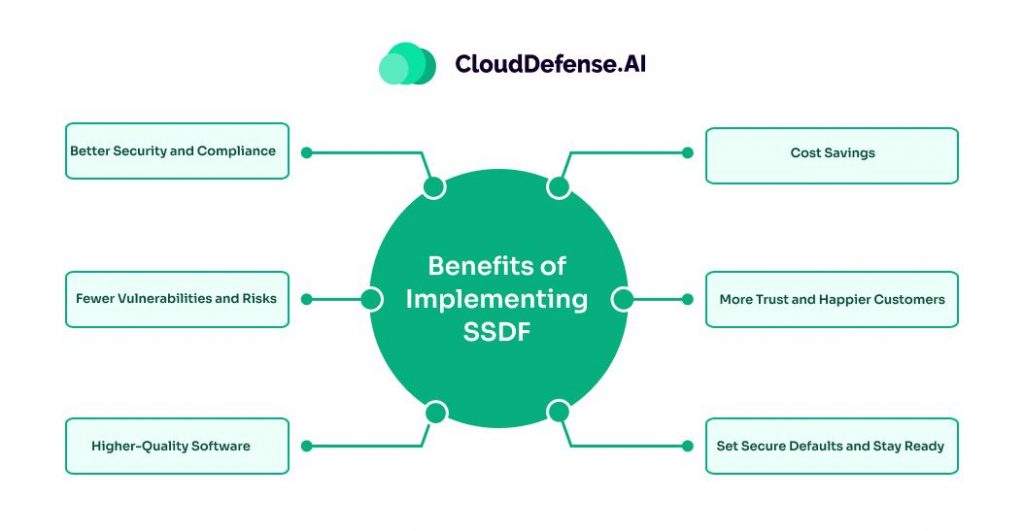
1. Better Security and Compliance
When you bake security into every step of the software development process, you’re not just protecting your code – you’re also keeping regulators off your back. By following these practices, you’re making sure your software is secure and that you’re meeting any legal requirements that come with it. It’s a win-win situation that saves you headaches later on.
2. Fewer Vulnerabilities and Risks
Catching security issues early means you’re less likely to deal with a full-blown crisis down the line. By focusing on security throughout development, you can spot vulnerabilities before they become big problems. This proactive approach helps keep your software safe from breaches and other security incidents that could cost you big time.
3. Higher-Quality Software
Good security practices do more than just keep hackers out as they make your software stronger overall. Following these guidelines will result in a more reliable product that runs better and has fewer bugs. It’s not just about security; it’s about building software that works well and keeps users happy.
4. Cost Savings
Fixing security issues after your software is out in the wild is expensive. The sooner you catch problems, the cheaper they are to fix. By addressing security early in development, you save money in the long run. It’s a smart investment that pays off by reducing the costs of post-launch fixes and potential breaches.
5. More Trust and Happier Customers
These days, people care about security and they want to know that the software they’re using is safe. By showing that you take security seriously, you’re building trust with your customers. This not only keeps them loyal but can also attract new customers who are looking for a company that prioritizes their safety.
How CloudDefense.AI Enhances Your Compliance and Security Efforts
When it comes to winning over new SaaS clients, trust is your biggest asset. In a world where data breaches and privacy concerns are all too common, showing that you’re serious about security is a game-changer.
Customers and partners want to know their data is safe, and having the right compliance certifications is a key part of proving that. Keeping that in mind, we make security and compliance a lot easier. Here’s how we make it happen:
- Automated Compliance Monitoring: CloudDefense.AI is your one-stop solution for effortless and comprehensive Multi-Cloud Compliance Management. We empower you to maintain automated compliance with industry-standard regulations
- Customizable Policies and Controls: We offer a range of customizable policies and controls that can be tailored to your specific needs. Whether you’re aiming to comply with your personalized policies or other standards like SOC 1, SOC 2, HIPAA, GDPR, or PCI DSS, our platform helps you build a strong compliance foundation.
- Aligned Requirements: We’ve mapped the requirements of NIST to our platform, so you can be sure your AppSec program aligns with SSDF standards. We provide the tools and processes needed to meet these requirements effectively.
- Comprehensive AppSec Platform: Our platform supports a variety of regulations with robust features. It offers differentiated user roles, detailed activity records, and extensive security controls throughout the software development lifecycle. From static application security testing (SAST) and software composition analysis (SCA) to API security, container security, and infrastructure as code, we’ve got you covered.
For instance, to meet the SSDF requirement PW.5 on secure coding practices, CloudDefense.AI utilizes SAST. This tool automatically scans your source code, detects vulnerabilities, and can even fix issues with just one click. Developers get real-time feedback, ensuring their code meets secure coding standards.
In simple terms, CloudDefense.AI takes the stress out of compliance and boosts your security across the board. This means you can build and keep trust with your clients and partners, even in a tough, competitive market.
